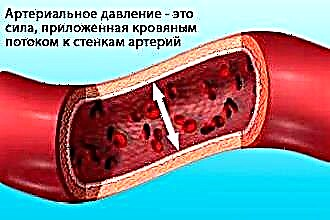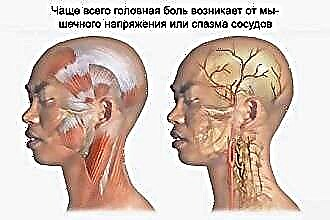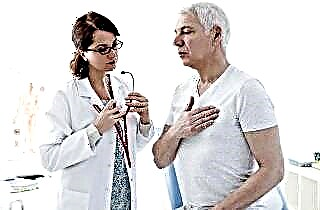The state of human health directly depends on the indicators of blood pressure (or blood). There are empirically established norms. Any deviation from them in the direction of decreasing or increasing is a pathological condition. Blood pressure can fluctuate depending on various factors, and this is normal. But if fluctuations become frequent and persist for a long time, you need to sound the alarm. An increased state of pressure, like a reduced one, requires compulsory treatment. Otherwise, complications may develop, which are often incompatible with life.
 Blood pressure - what is it? This is the force of the blood flow pressing on the arteries from the inside. The pressure inside the heart muscle is called cardiac, in the capillaries - capillary, in the veins - venous. This parameter is measured in millimeters of mercury or water column (in veins).
Blood pressure - what is it? This is the force of the blood flow pressing on the arteries from the inside. The pressure inside the heart muscle is called cardiac, in the capillaries - capillary, in the veins - venous. This parameter is measured in millimeters of mercury or water column (in veins).
In the arteries, the intensity of the pressing force changes, its readings depend on the work of the heart. At the moment of contraction of the heart muscle and the expulsion of blood into the vessels, systolic pressure arises, while the heart is in a relaxed state, diastolic pressure appears. Thus, the magnitude of the force acting on the vessels is determined by two parameters: upper (systolic) and lower (diastolic).
The blood is in a cyclical movement all the time, saturating the body with oxygen and nutrients. Insufficient or excessive supply of blood to organs and tissues leads to a malfunction in all systems of the human body. To answer the question of what blood pressure is, you need to understand how it arises, what affects its formation.
The rate of movement of blood through the vessels is determined by the strength and heart rate. Arterial or blood pressure occurs when blood moves from the heart through the arteries.
With each push of the heart muscle, the pressure reading changes from maximum to minimum.
The force that squeezes the vessels is influenced not only by the work of the heart, but also by the work of the vessels themselves. They have the ability to contract or expand in response to external stimuli. The poor state of the vessels causes deviations in blood pressure indicators in one direction or another.
The pressure in the vessels varies. In those vessels that are closest to the heart and which are larger, the blood has a stronger effect on the walls.
The blood thrown out by the heart into the artery is carried through the body and enters the capillaries. The walls of small vessels resist the blood flow acting on them. The greater this resistance, the higher the diastolic reading will be.
What primarily affects the value of blood pressure?
- Blood consistency, which may be thin or viscous.
- The volume of blood flow that travels through the veins to the heart.
- The volume of blood expelled by the heart into an artery.
- The strength of the resistance of arteries and capillaries to blood flow.
- The state of the vessels (elasticity of the walls, the width of the lumen).
- Changes in the intensity of the effect of the blood flow on the vessels of the thoracic region and the peritoneal region, which occur during respiratory movements.
In addition, the lifestyle contributes to the formation of certain indicators of blood pressure: nutrition, emotional sphere, mental and physical stress, physical activity, the amount of sleep and rest, the presence of harmful inclinations.
The parameters of the blood current can also be influenced by:
- climatic and weather conditions;
- chronic diseases;
- the age and gender of the person;
- use of medications;
- genetic predisposition.
The value of blood pressure may fluctuate slightly even during one day, before and after meals, with a change in body position.
Blood pressure norms
To better understand what blood pressure is, you need to understand the concept of its norm. The approach to determining the optimal standard has undergone several changes. For a long time, the individual rate for each person was calculated according to a certain formula, taking into account the age and weight data of the patient.
To determine the systolic indicator, it was required to perform the following actions: by half of age, add a tenth of the weight and the number 109. The diastolic indicator could be found in this way: add a tenth of age to one fifteenth of the weight and add the number 63.
Another common method to determine the norm of blood pressure were, and still are, tables showing the approximate age of the patient, gender, and the values of upper and lower pressure corresponding to these parameters.
According to these two approaches, tonometer readings, for example, 150 to 90, can be considered an individual norm for a person of certain years, having a certain weight.
What is normal blood pressure in the modern interpretation? The most current view of the norm in relation to blood flow strength indicators is as follows: the standard, most preferred value of systolic and diastolic indicators is 120/80 mm. rt. Art. Any deviation from the standard is considered to be a pathology of varying severity.
Thus, all blood pressure values can be divided into the following categories:
- Normal increased: the upper figure is 121-129, the lower one is 81-84.
- The borderline state preceding hypertension: the upper parameter is 130-139, the lower one is 85-89 (or normal with high values).
- Arterial hypertension, degree one (easy option): the upper value is 140-159, the lower one is 90-99.
- Arterial hypertension, degree two (moderate): the upper indicator is 160-179, the lower one is 100-109.
- Arterial hypertension, the last degree (severe): the upper value is 180 or more, the lower value is 110 or more.
- A separate type of blood pressure values corresponds to systolic hypertension (it is called isolated), which is characteristic mainly of the elderly. Its parameters: the upper indicator is more than 140, and the lower one is less than 90.
So, when there is an understanding of what blood pressure is and its rate, you can easily recognize a pathological condition.
Systematic deviations in the direction of increasing the standard pressure parameters are already hypertension.
If the violation of the norm has occurred in the direction of decreasing, then there is hypotension. Both conditions are pathological and require correction. Each of them has its own characteristics and causes of development.
Hypertension
The peculiarity of the disease is that it "sneaks up" imperceptibly. Existing for a long time in an asymptomatic state, hypertension is slowly doing its job, worsening the state of blood vessels and heart muscle. In addition, under its influence, the kidneys, eyes, and brain begin to suffer.
Signs become clearly pronounced in the later stages of the disease, when it is impossible to do without drug therapy. Here are the main ones:
- flickering black dots before the eyes;
- severe prolonged headaches;
- nausea;
- heart pain;
- arrhythmia;
- dyspnea;
- dizziness;
- tinnitus;
- swelling;
- deterioration of vision;

- chronic weakness;
- irritation;
- bad dream.
The reasons for the development of the disease:
- background disease;
- side effects of drugs;
- wrong lifestyle;
- emotional instability;
- bad heredity.
Hypotension
A condition that also gives a person a lot of trouble, and can lead to negative consequences. Here are its signs:
- lethargy and apathy;
- chronic fatigue;
- drowsiness;
- fatigue quickly sets in;
- often darkens in the eyes, especially with sudden movements;
- headache often;
- a feeling of weakness in muscle tissues (legs give way);
- "Seasickness" when traveling in transport;
- periodically dizzy;
- photophobia, sensitivity to harsh noises;
- hands and feet are constantly freezing;
- pallor of the skin and lips.
What causes this condition:
 chronic overwork, both physical and mental, and mental;
chronic overwork, both physical and mental, and mental;- lack of sleep;
- large blood loss;
- postoperative condition;
- chronic diseases that exhaust the body;
- adverse drug reaction;
- dehydration, long stay in a stuffy and hot room or in the open sun;
- intoxication caused by poisoning or inflammation in the body;
- poor or inadequate nutrition;
- the presence of background diseases.
What is blood pressure in children and adolescents
Pressure in childhood and adolescence has its own characteristics. It, of course, differs in its values from the adult parameters. A baby with a height of 50 cm and weighing 3500 g cannot have the standard indicators of 120/80, characteristic of an adult who is much larger than a newborn in size.
A newborn baby can have indicators of 60/40, and this is completely normal for him.
By the end of the first year of life, the child will reach values of approximately 100/60.
The baby will come to ideal indicators, taken as standard, only by the age of 10.
But for adolescents, the norm will be parameters slightly exceeding the standard norm for an adult. They can reach values of 136 to 86. This is due to hormonal disruption in the body associated with active growth and puberty. Abrupt changes in tonometer indicators (hypertensive crises) in adolescents are not uncommon, this poses a danger to the general state of health and even life.
The following factors can lead to high blood pressure in children and adolescents:
- diseases of the heart, kidneys, endocrine system, brain damage;
- oxygen deficiency;
- lack of vitamins;
- poor nutrition;
- obesity;
- hypodynamia;
- excessive passion for salty foods (chips, crackers are especially harmful);
- suppressed or hidden emotions.
How to measure blood flow
To understand visually what blood pressure is, it helps to measure it with a tonometer. The most accurate is a hand-held tonometer. It is a cuff for inflating air, a bulb that acts as a pump, a device with a scale of digital pressure values. All these elements communicate with each other by tubes. A phonendoscope for listening to tones is attached separately.
Step-by-step guide to measuring pressure:
- Drain excess air from the cuff by pressing on it with your hands.
- Place the cuff on the arm just above the elbow joint.
- Place the phonendoscope on the brachial artery in the elbow bend area.
- Inflate the cuff with air.
- Begin to smoothly release the air, listening to the sounds that appear and noting the corresponding values on the scale.
- The first knock will indicate the upper pressure, and the last - the lower.
Some features of the procedure:
- Measure the pressure at the same time, preferably in the morning and at night.
- To accurately establish indicators, you need to measure pressure for several days in a row.
- Indicators are measured in different positions of the body and on different hands in order to have a complete picture of the patient's condition.
- The bladder must be emptied before the procedure.
- Manipulations with the tonometer are carried out no earlier than 30 minutes after eating, smoking a cigarette.
- A person must first come to a calm state.
- It is impossible to expose the body to physical activity before measuring pressure.
- When measuring, it is necessary to make allowances for general well-being, the presence of diseases, pain syndrome, and the use of medicines.
History reference
The first to understand what blood pressure, which can and must be measured, was the English scientist S. Hales. He performed this procedure on a horse by directly inserting a glass tube into the artery of the animal. This event happened in 1773.
In 1828, French physician Jean-Louis Marie Poiseuille used a similar method to measure blood pressure in a rabbit. To do this, he placed a glass tube full of mercury in a U-shaped glass tube in his heart. So he was able to figure out the contractile force of the left ventricle of the heart muscle. However, this method was still barbaric and was in no way suitable for measuring pressure in humans.
1896 was a breakthrough in blood pressure measurement. S. Riva-Rocci, a pediatrician from Italy, put forward a proposal to use a bicycle tire, a mercury sphygmomanometer connected to it, and a rubber bulb. A stream of air was launched into the splint wrapped around the arm in the forearm area. Then it was slowly released. After that, the pulse was monitored: the first and last tremors were noted. The numbers that corresponded to them were indications of the force pressing on the walls of the vessels (upper reading and lower). Later, this method was improved, the tire was replaced with a cuff.
In 1905, a surgeon from Russia, N. S. Korotkov, further modernized the already known method of measuring pressure. With his submission, listening to the pulse to determine the level of blood pressure began to be carried out with a stethoscope, placing it on the radial artery. The first tones that can be heard on the device indicate systolic pressure (a measure of cardiac output), and the last audible tones indicate diastolic pressure (measures the resistance of the artery walls). If you subtract the lower pressure from the upper numbers, you can determine the pulse pressure.
The optimal mean blood pressure (120/70) was derived after blood pressure measurements in a large number of patients who had been thoroughly examined beforehand.
However, quite often one has to deal with the so-called "individual" norm. It may differ slightly from the generally accepted standard in one direction or another. But this is precisely the norm at which a particular person feels good, while his health does not suffer.
Interesting medical facts and tips
- Headache with increased tonometer readings is not always present. Sometimes a person feels discomfort in the area of the heart or does not feel anything at all.
- The situation is misunderstood by patients who take medications only during attacks of increased blood pressure, and stop taking them after they feel better. Hypertensive patients need to take pills all their lives.
- The increase in pressure with age is not the norm and needs to be corrected.
- Young hypotonic with the advent of old age may well become hypertensive.
- It is a mistake to take medications that your mother or friend advised. They can help, but only by sheer coincidence, if the medicine is suitable for a sick person. The doctor should prescribe antihypertensive drugs, individually approaching each patient.
- The so-called "working pressure" or individual rate requires treatment if its values deviate significantly from the standards. Even if a person's well-being is normal, altered pressure can have a latent negative effect on the body.
- Not always people with a hereditary predisposition become hypertensive. The key to the health of any person is a healthy lifestyle and a positive perception of the surrounding reality.
- Drugs that must be taken for life in the presence of persistent high blood pressure do not cause addiction. Therefore, it is not worth changing them, this can only worsen the situation. It is necessary to switch to new drugs only as directed by a doctor.
- Some birth control pills can cause high blood pressure in women.
- A separate group of antihypertensive drugs can lead to sexual dysfunction in men.
- Hypotensives are more often attracted to sweets, and they like to sleep a lot.
- Low blood pressure should not be neglected, it can be a sign of latent pathology.
Blood pressure characterizes the state of the cardiovascular system, it affects the vital activity of the whole organism. When determining the level of pressure, one must adhere to the generally accepted norm, as well as take into account the individual characteristics of a person. Hypotension and hypertension equally need treatment, even in the absence of alarming symptoms, if the tonometer readings deviate significantly from normal. Diseases of internal organs can carry a latent threat, therefore, upon detecting a change in normal pressure, it is necessary to undergo a full-fledged medical examination.


 chronic overwork, both physical and mental, and mental;
chronic overwork, both physical and mental, and mental;

